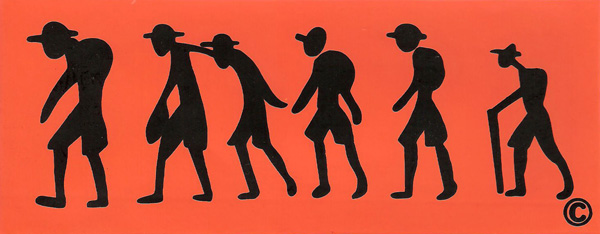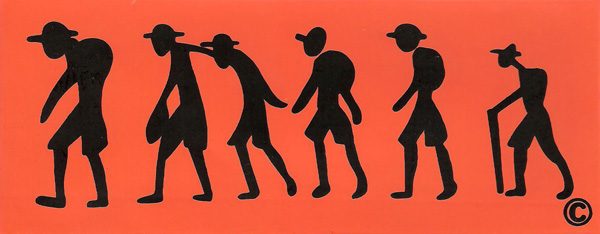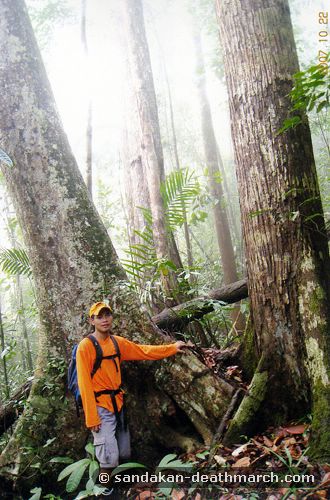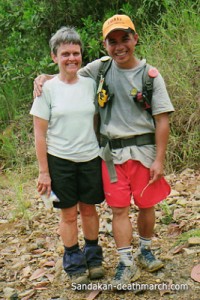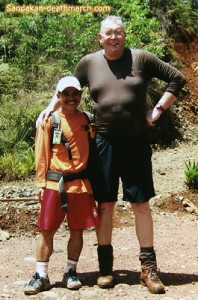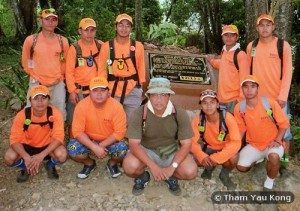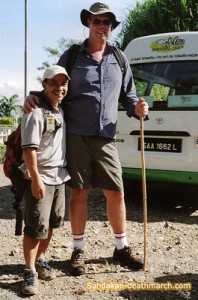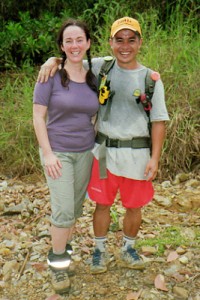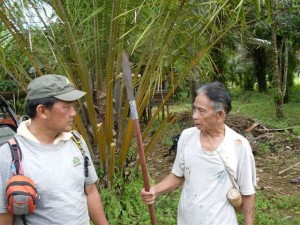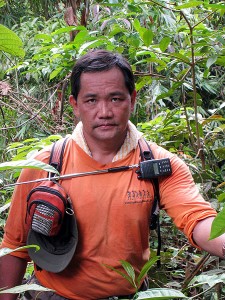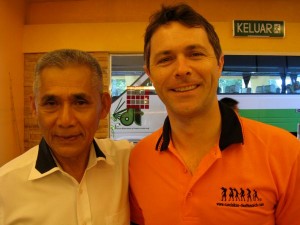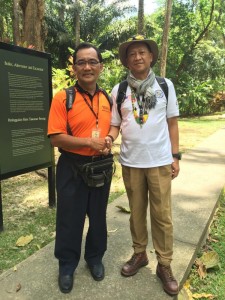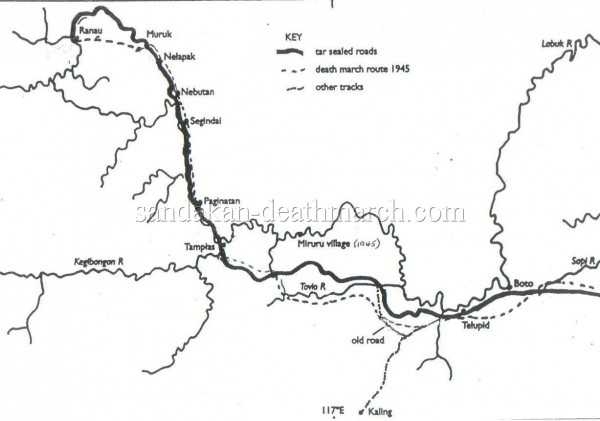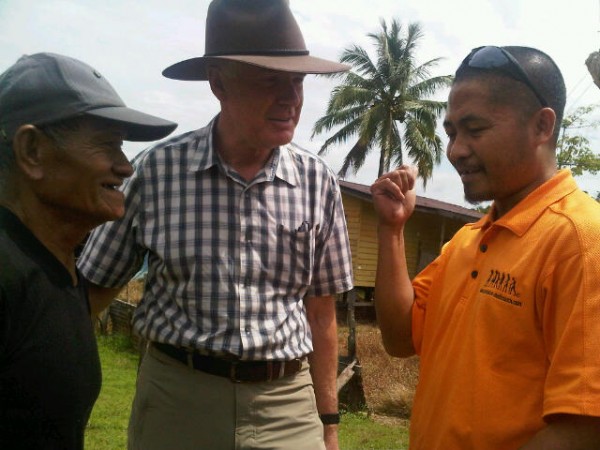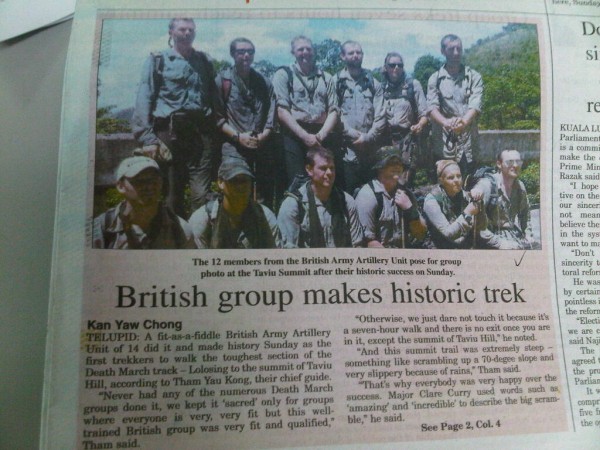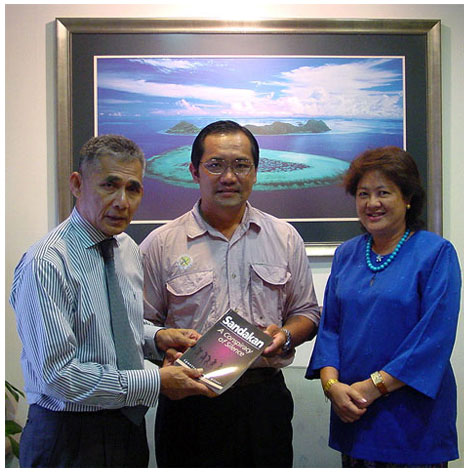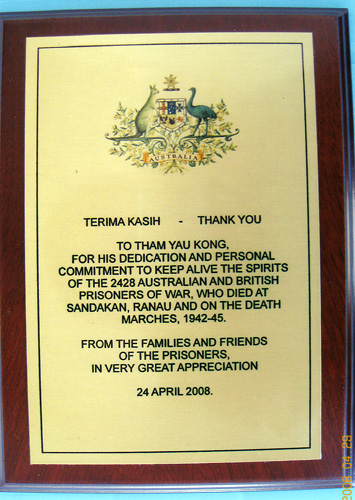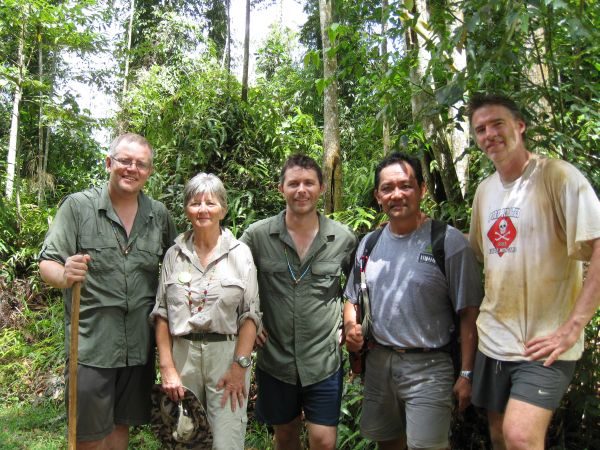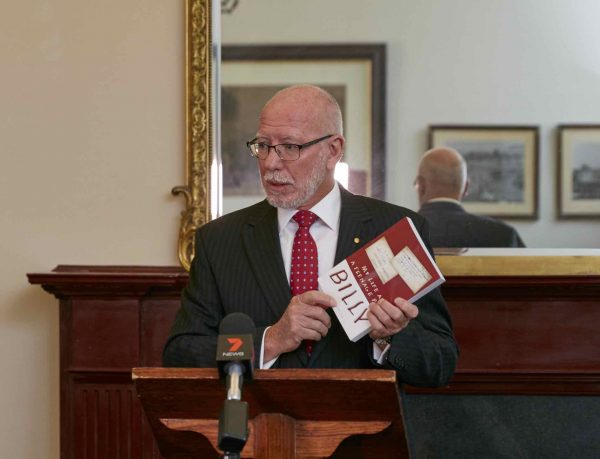LEST WE FORGET
Welcome to our website and details on how you can retrace the route of the infamous Sandakan death marches with Lynette Silver, the renowned World War 2 historian, and Tham Yau Kong, Sabah’s premier trekking specialist and managing director of TYK Adventure Tours, Sabah, Malaysian Borneo.
ABOUT US
Tham Yau Kong, a highly respected and expert jungle trekker, has many years of experience in the adventure tourism industry in Sabah. Historian Lynette Silver is recognised as the world’s leading authority on the WW2 history of Sandakan and the death marches. In 2005, Tham and Lynette were solely responsible for identifying the route of Sandakan-Ranau death marches, including the long-forgotten middle section, which had been lost for sixty years. Their knowledge of the track is unparalleled and they have received many accolades and awards from the Australian, Malaysian and Sabah governments for excellence in their respective fields.
TYK’s safety record is equally impressive. Since opening up the route in 2006, Tham’s highly trained team has escorted many hundreds of trekkers along the route, without incident.
As trekkers deal directly with Tham’s company, TYK Adventure Tours offers by far the best value for money, as well as great flexibility to cater for groups with individual needs. There is no middle man and, since all TYK staff are local people, all financial benefit remains in Sabah. The historical services of his honorary consultant, Lynette Silver, who is domiciled in Australia and is available to answer any particular queries not covered on the website, are exclusive to TYK.
Please note that TYK Adventure Tours is not associated with, nor is it connected in any way to an Australian-based tour company, which has registered website domain names almost identical to that used by TYK to promote its treks since 2005. Your guarantee of authenticity is TYK’s unique logo.
This logo is also your guarantee that you are following, as close as is practically possible, the death march route taken by the POWS. This track, identified by the 1945 Army team sent to recover the bodies, was mapped. The original map, examined and endorsed by the relevant authorities, is on public display in the Australian Government’s Commemorative Pavilion at Sandakan Memorial Park, and at Kundasang War Memorial. (see ‘tours page’ for details)

Winning Tourism Malaysia Award 2005/2006 on 22 July 2007
for the “Most Innovative Tour Operator” – Sandakan Death March tour innovation.Sabah’s Tourism Minister, Datuk Masidi Manjun, with Tham Yau Kong and Lynette Silver, following the presentation of the Award
What are the Sandakan Death Marches?
Sandakan and the Death Marches, 1942-1945
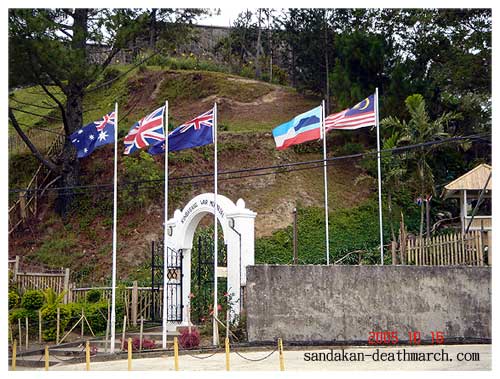
Imagine this. It is May 1945. Clad only in ragged loin-cloths, over 500 skeletal creatures, barely recognisable as human, struggle to their feet at the Sandakan POW Compound, on Sabah’s north-east coast. Three long years in captivity, half of them on starvation rations and with little or no medical attention, have taken their toll. The grimy, wasted bodies of these once fit and strapping Australian and British servicemen are covered in sores and scabies, their filthy hair and beards matted and lice-infested. Many are suffering from tropical ulcers, some so large that shin bones are clearly visible. Others, bloated from beriberi, lumber along on sausage-like legs. They are bound for Ranau, a small village on the flanks of Mt Kinabalu, South East Asia’s highest peak, situated 250 kilometres away to the west, in the rugged Borneo jungle interior.

Why were the POWs in Sandakan ?

All were members of a 2700-strong Allied contingent transferred to Sandakan by the Japanese in 1942-43, following Singapore’s fall. Their task? To construct a military airfield, using not much more than their bare hands.

For the first twelve months or so, conditions at Sandakan were tolerable. However, in mid 1943 the Japanese discovered that the POWs not only had a radio but were in league with a local resistance organisation. The kempei-tai, or secret police, swooped. Arrests and transfers followed. Discipline at Sandakan was tightened considerably and life became much more difficult for the remaining 2,434 prisoners.
Why were they marching to Ranau?

As the war ground on, conditions deteriorated. In late January 1945 the Japanese decided to move 455 of the fittest prisoners to Jesselton (Kota Kinabalu) to act as coolie labourers – only to halt them at Ranau, owing to Allied air activity on the west coast. At the end of May, there was a second march from Sandakan and in mid-June a third, comprised of only 75 men.
As both sea and air were under the complete control of the Allies, a track had been cut through the mountains, linking existing bridle-trails. Unaware that it was to be used by POWs, the local headmen given the task of creating this track had deliberately routed it away from any habitation, across the most inhospitable and difficult terrain possible.
There was no medical assistance and little food. Anyone who could not keep up was ‘disposed of’. Despite this, about half the prisoners completed the march, only to die at Ranau from illness, malnutrition and ill-treatment by their captors. Two Australians managed to escape in the early stages of the second march with the help of villagers, and four more successfully escaped from Ranau into the jungle, where they were cared for by local people.
What happened to the rest of Sandakan’s prisoners?
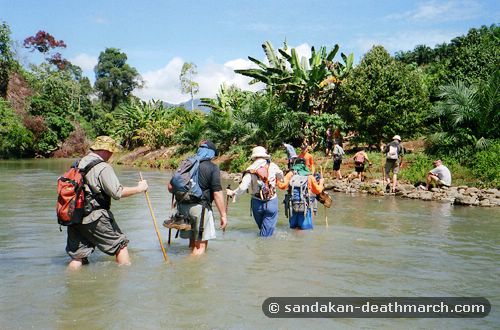
Back at Sandakan, 200 prisoners unable undertake the second and third marches also died, bringing the death toll there to about 1400. Of the 1000-odd prisoners who left on the death marches, about half died in the attempt. The rest died at their destination.
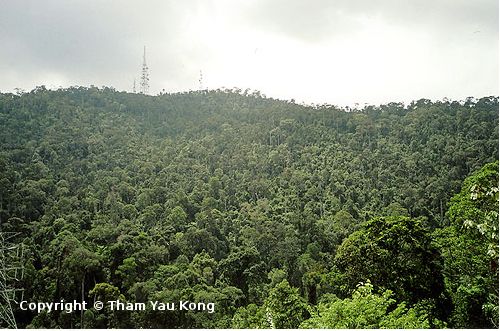
The story of Sandakan and the death marches is one of the most tragic of World War Two. It is also one of the most heroic. Despite appalling conditions, the prisoners never gave up. Their heroism, their determination and their indomitable spirit are testimony to the strength of the human spirit and an inspiration to all. Of the 2434 prisoners incarcerated at Sandakan, 1787 were Australian. The remaining 641 were British. The six Australians who escaped were the sole survivors.
Re-tracing the Death March Track (Sandakan Death March)
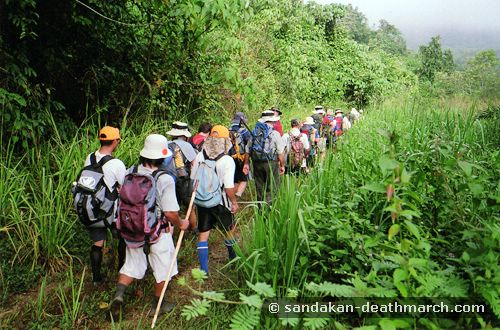
The track cut for the death marches soon became completely overgrown and for sixty years defied all efforts to locate it. However, in August 2005, Australian investigative writer and historian, Lynette Silver, author of the internationally acclaimed book Sandakan – A Conspiracy of Silence, and Tham Yau Kong, a multi tourism award winner, who has almost twenty-years‘ experience in the industry, combined their considerable talents to identify the path taken by the prisoners of war. After sixty years, you too can now walk in the footsteps of the Death March heroes.
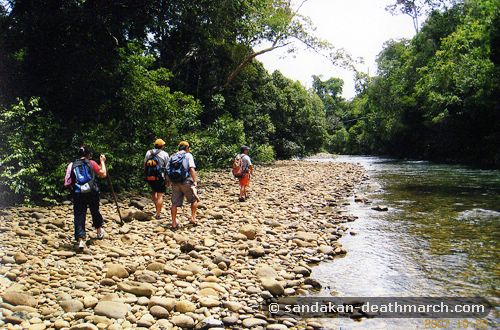
Trekking tours cover the last 140 km of the route across the mountains, of which about 100 km involves actual walking. This is by far the most interesting, scenic and challenging section. The first 100 km, from Sandakan to Bauto, is no longer forested, and has been heavily planted with oil palms. The track through this section consists of often muddy estate roads, which have obliterated all traces of the original path. However, while this sector is not suitable for trekking groups, Tham Yau Kong has created a specially designed four-day/three-night mountain biking/cycling tour, which allows participants to visit historical POW sites not readily accessible to trekkers. Details of this cycling tour are here. Cycling is also available, on request, as an optional extra to private trekking groups.
How can I follow the Sandakan Death March Track?
To experience walking on this historic track, TYK Adventure have specially designed the following tours:
(Please click on the tour below for more information)
- two-day semi-adventure tours (Sandakan Track Mini-highlights)
- twelve or eight-day Premium Treks
- eight-day budget trek
- student adventure programs
Tham can also arrange custom-made itineraries to suit individual requirements and budgets.

All that is required is to ensure an adequate level of fitness for the tour you select. Challenge Walkers will be emailed an outline of the fitness level recommended, along with other information, after you book a place on the tour. Unlike the prisoners of war, after the day’s walk you will be well fed and have comfortable board and lodging. For the Sandakan Track Mini-highlights Walk, all meals are provided and accommodation is at a tea plantation.

Anzac Day Tours: Those unable to undertake a trek tour, due to age or physical condition, may like to consider joining the annual Anzac Day Tour which offers a high degree of comfort, and an optional short walk along the death march track. See www.lynettesilver.com for contact details.
Labuan War Cemetery: The three-day tour can be extended to allow participants to visit Labuan War Cemetery, a one-day excursion from Kota Kinabalu. Please advise at time of booking if this option is required. This excursion is included in the 11-day tour.
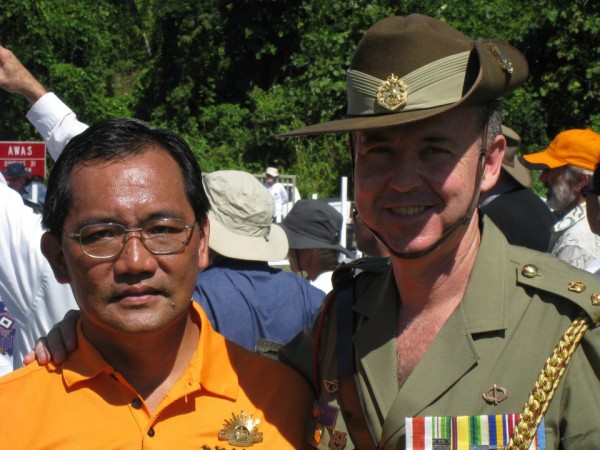
Lt. Col. Mick Birtles, formerly with Australian High Commission and now back in Australia, was attending the unveiling of Last Campsite Memorial in Ranau. (Sabah)
Map of the trek route
To sample some of the documentaries made on the POW story and our trek, click here
HISTORIC TREK
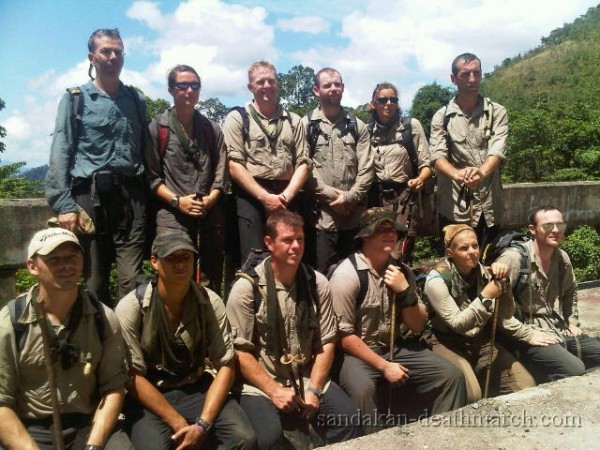
On 21 August 2011, a team of British soldiers made history by being the first, and only, trekking group to successfully climb the most difficult and gruelling section of the death march track, while undertaking a full march along the death march route from Sandakan Camp to the Last Camp at Ranau. While investigating the POW route, the TYK team had identified this section, from a Japanese Camp site on the Lolosing River to the summit of Taviu Hill, some time previously. However, as the route passes through highly protected Class 1 Forest, and part of it is subject to flash flooding, trekking groups had always ascended Taviu Hill via a less environmentally intrusive, safer, and physically less demanding route, a short distance away.
With increased interest in the Sandakan Track after the successful British expedition, Sabah’s Forestry Department investigated the possibility of opening the area to other trekking groups. On 3 January 2012, as a result of an environmental impact study, it was announced that the protected area was permanently closed, a decision based on environmental and safety considerations, and that all trekking parties must continue to use the long established alternate route. In the interests of protecting this beautiful and environmentally precious area, TYK fully endorses and supports this decision. Although no further access to the protected area is permitted, photos of the Lolosing-Monkilua section can be viewed by clicking onto ‘Lolosing Section’ on the menu bar on the home page.
To hear what Major-General Chris Chris Wilson, British Army, has to say about the outstanding support and organisation supplied by the TYK team, which he described as ‘second to none’, click onto the video below.
British Major General Chris Wilson speech on 27 August 2011
JUST SOME OF OUR TRIUMPHS FOR SANDAKAN DEATH MARCH
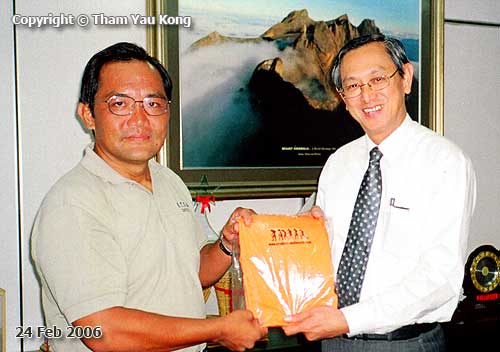
DM Trek and Historical / Battlefield Tour supported by Former Ministry of Tourism, Environment Development, Sabah — Tan Sri Datuk Chong Kah Kiat
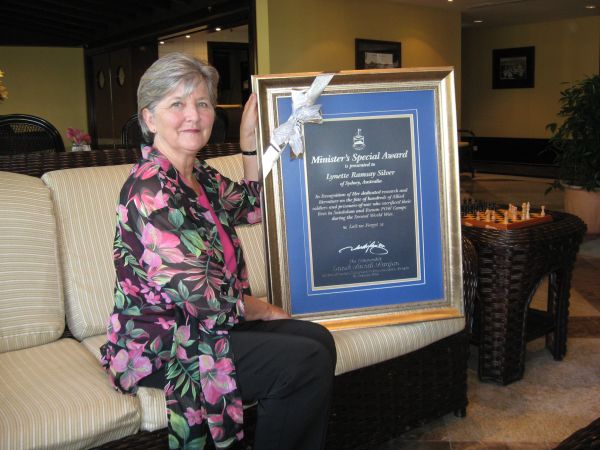
Lynette and Minister’s Special Award
(Left) Chairman of Sabah Tourism Board Dato Sri Tengku Zainal Adlin. (Right) Genaral Manager of Sabah Tourism Board Datuk Irene Benggon Charuruks.
Tham’s Appreciation Plaque from the Australians
Australian Parliamentary Mateship Trek
Scott Morrison (Federal Opposition MP), Lynette Silver, Hon Jason Clare (Assistant Minister for Defence), Tham Yau Kong and Robert Oakeshott (Federal Independent MP), on Taviu Hill, April 2011.
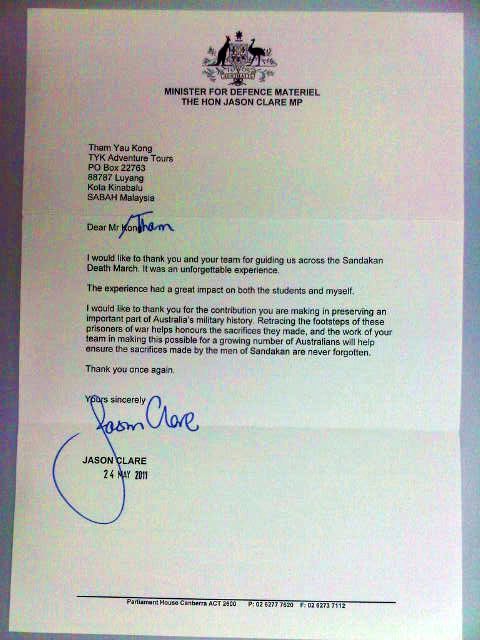
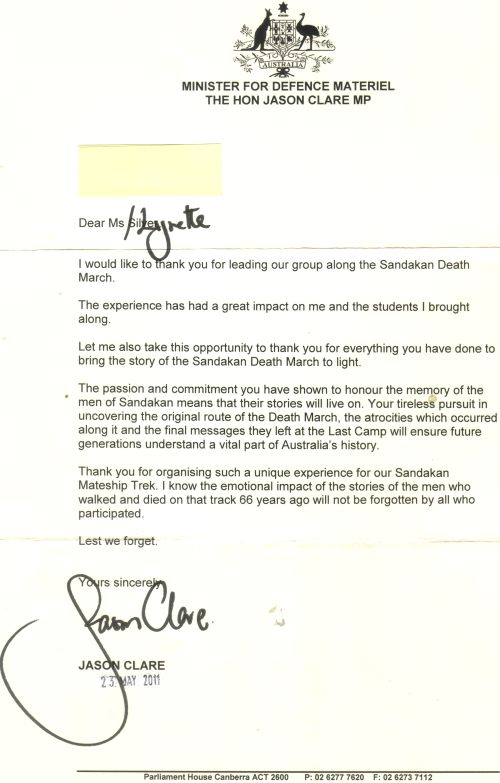
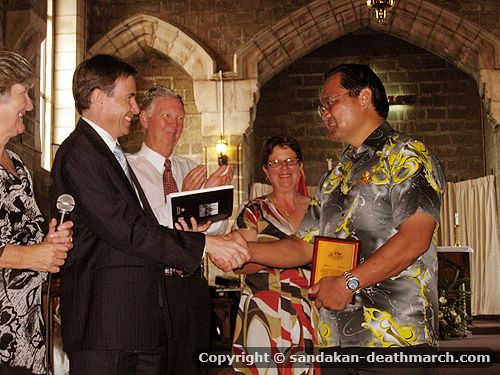
Presentation by Australian Deputy High Commissioner to Malaysia Mr. Richard Maude to Tham Yau Kong in St. Michael Church, Sandakan on 24th April 2008.
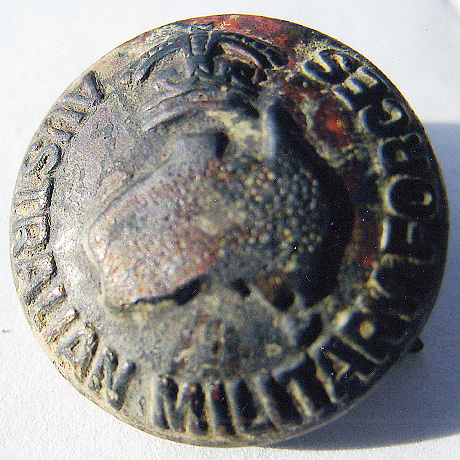
Found in POWs LAST CAMPSITE in August 2008

LAST CAMPSITE Memorial 27 August 2009
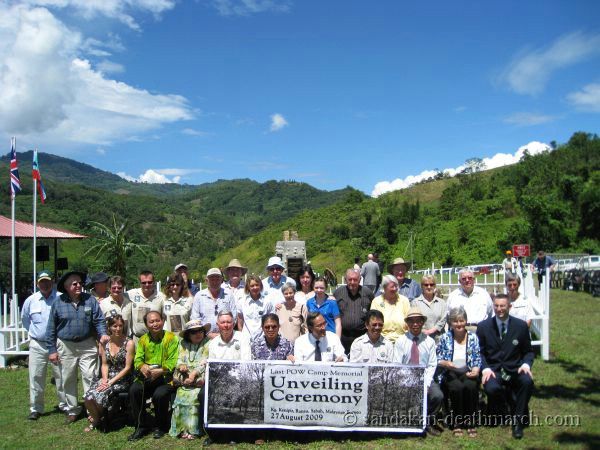
VIPs at Unveiling Ceremony
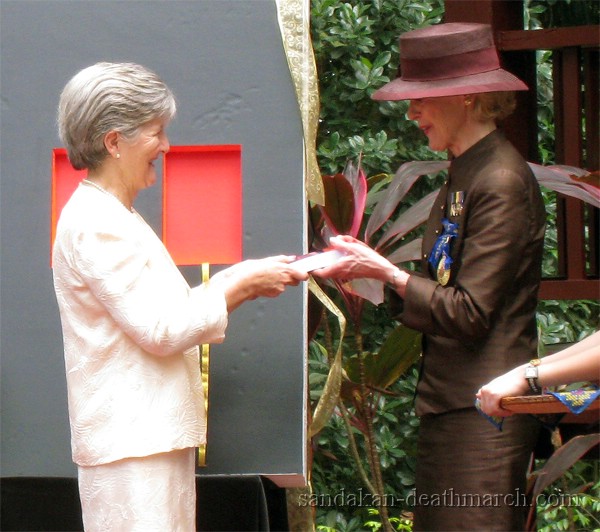
Governor General of Australia launches Lynette Silver’s book, ‘Blood Brothers’, 2010.
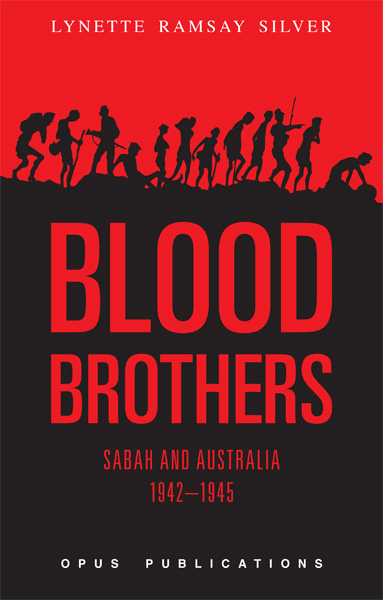
‘Blood Brothers’, 2010
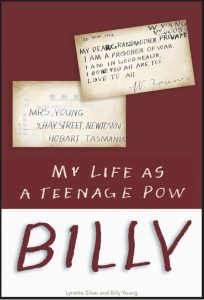
‘Billy: My Life as a teenage POW’, 2016
Governor of NSW, General David Hurley, launching ‘Billy: My Life as a Teenage POW’, 2016
